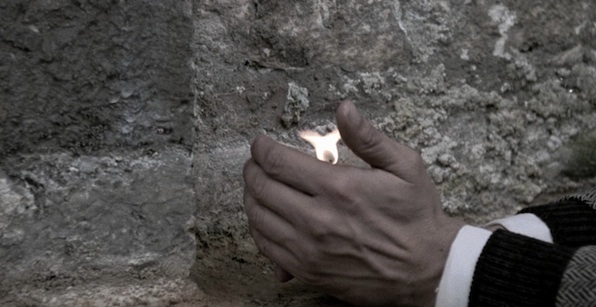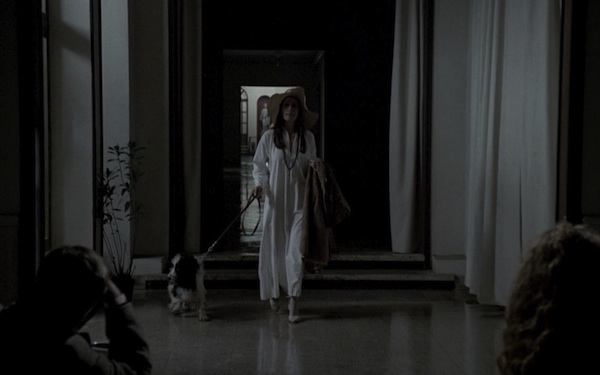Of all the images and moments captured in the oeuvre of legendary Russian director Andrei Tarkovsky, perhaps the single most celebrated shot is the nine-minute uninterrupted take in his penultimate film Nostalghia, of Andrei Gorchakov (Oleg Yankovsky) attempting to carry a candle across a pool in memory of his late friend Domenico (Erland Josephson). For Tarkovsky, this was not only a career achievement, but literally the shot of a lifetime.
According to Yankovsky, when he first met Tarkovsky to discuss the filming, the director asked the actor to help him fulfill a grand idea to “display an entire human life in one shot, without any editing, from beginning to end, from birth to the very moment of death.” Tarkovsky visualized life in the form of a candle. “Remember the candles in Orthodox churches, how they flicker. The very essence of things, the spirit, the spirit of fire.” And so the act of carrying the candle across the stagnant pool was nothing less than the effort of an entire lifetime encapsulated in one gesture. “If you can do that,” Tarkovsky challenged Yankovsky, “if it really happens and you carry the candle to the end–in one shot, straight, without cinematic conjuring tricks and cut-in editing—then maybe this act will be the true meaning of my life. It will certainly be the finest shot I ever took—if you can do it, if you can endure to the end.”
Watch Andrei Tarkovsky’s Cinematic Candles.
Tarkovsky’s highly evocative metaphor of a lifetime in one shot leaves me thinking how all shots might be seen as a self-contained life, with a beginning, duration and end. This certainly raises the stakes for what a shot is expected to accomplish and what we seek from watching it. When we consider that a shot not only contains the sliver of life that it captured, but also a sliver of ours, however many seconds or minutes it occupies of our brief existence on this planet, why shouldn’t we expect from each shot nothing less than life fully realized?
Perhaps this is why Tarvovsky’s Nostalghia has relatively few shots: 123 total in its 125-minute running time, or an average of 1 minute 1.2 seconds per shot. This is one of Tarkovsky’s most contemplative and introspective works, and his most despairing. His first film made outside the Soviet Union, with his relationship with its film authorities in dissolution and at risk of never seeing his wife and son again, Nostalghia is a film that aches to find meaning and purpose in a world turned alien and empty. In this search, the cinema itself is both called into question and called to duty. Roaming through gray landscapes and tracks across shadowy interiors, the camera is challenged to turn a pervasive mood of melancholy into unexpected moments of beauty that clarify Tarkovsky’s yearning for fulfillment.
Here is where the film’s other cinematic metaphor, the candle, helps in further illuminating Tarkovsky’s cinema. What if we were to see every shot in this film as a cinematic candle, flickering its existence away until it goes out? That sense of fragility, each shot at the brink of being extinguished, gives a special pathos to the film, one that echoes Tarkovsky’s vulnerable state when making this film. Within the first forty seconds, half of the shots are over; that’s a far longer average than in most movies, but in Tarkovsky’s world it feels like a mass slaughter of images. By the one-minute mark, a third of all shots remain; by two minutes, we are down to seventeen. Remarkably, about half of those shots make it to the three-minute mark. These are the signature shots of the film, and it would be fascinating to see what kind of movie could be assembled just of those eight epic long takes.
Half of those eight shots make it past the four minute mark. There’s a kind of mathematical pattern to the reduction of shot lengths, with half the shots eliminated by each minute mark. True to form, only two shots reach five minutes: the candle scene and a virtuoso tracking shot that marks a critical moment between Andrei and his would-be lover.
Another quality of Nostalghia emerges if you look at the early section of the video, with all 123 shots in the film arranged chronologically from top to bottom. You’ll notice that the early shots of the film are distinctly darker than the later shots. The color and brightness of the film’s visual design gradually moves from darkness to light, following its protagonist’s search for enlightenment.
Those familiar with some of my recent work might realize that we are now talking in terms of cinemetrics, the statistical analysis of film form. (This video essay is dedicated to Yuri Tsivian, film scholar at the University of Chicago and leading cinemetrics practitioner – he manages the Cinemetrics database that collects cinemetric data on thousands of movies). I like using cinemetrics as a way of understanding the structure of a film like Nostalghia, if only so that I can find a way to visualize that structure in a way that can articulate the essence of what I find beautiful about it. Here we have a film whose shots amount to an array of 123 candles, some that flicker for just a few seconds, while a handful carry on defiantly against their imminent extinction. And one shot in particular that defines the heroic struggle of Tarkovsky’s artistry.
Note: an earlier version of this article listed the number of shots in Nostalghia at 116. Upon closer inspection the number of shots equals 123. The article and video have been revised to account for this correct figure.
Kevin B. Lee is a filmmaker, critic, video essayist and founding editor of Keyframe. He tweets at @alsolikelife.





